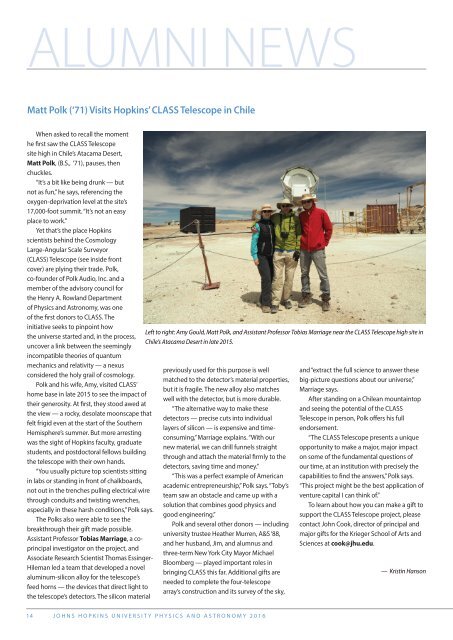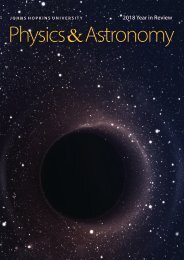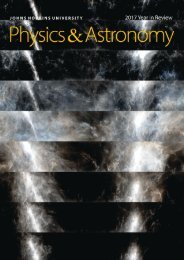2016_PA_Newsletter_12_29_16_FINAL
You also want an ePaper? Increase the reach of your titles
YUMPU automatically turns print PDFs into web optimized ePapers that Google loves.
ALUMNI NEWS<br />
Matt Polk (‘71) Visits Hopkins’ CLASS Telescope in Chile<br />
When asked to recall the moment<br />
he first saw the CLASS Telescope<br />
site high in Chile’s Atacama Desert,<br />
Matt Polk, (B.S., ‘71), pauses, then<br />
chuckles.<br />
“It’s a bit like being drunk — but<br />
not as fun,” he says, referencing the<br />
oxygen-deprivation level at the site’s<br />
17,000-foot summit. “It’s not an easy<br />
place to work.”<br />
Yet that’s the place Hopkins<br />
scientists behind the Cosmology<br />
Large-Angular Scale Surveyor<br />
(CLASS) Telescope (see inside front<br />
cover) are plying their trade. Polk,<br />
co-founder of Polk Audio, Inc. and a<br />
member of the advisory council for<br />
the Henry A. Rowland Department<br />
of Physics and Astronomy, was one<br />
of the first donors to CLASS. The<br />
initiative seeks to pinpoint how<br />
the universe started and, in the process,<br />
uncover a link between the seemingly<br />
incompatible theories of quantum<br />
mechanics and relativity — a nexus<br />
considered the holy grail of cosmology.<br />
Polk and his wife, Amy, visited CLASS’<br />
home base in late 2015 to see the impact of<br />
their generosity. At first, they stood awed at<br />
the view — a rocky, desolate moonscape that<br />
felt frigid even at the start of the Southern<br />
Hemisphere’s summer. But more arresting<br />
was the sight of Hopkins faculty, graduate<br />
students, and postdoctoral fellows building<br />
the telescope with their own hands.<br />
“You usually picture top scientists sitting<br />
in labs or standing in front of chalkboards,<br />
not out in the trenches pulling electrical wire<br />
through conduits and twisting wrenches,<br />
especially in these harsh conditions,” Polk says.<br />
The Polks also were able to see the<br />
breakthrough their gift made possible.<br />
Assistant Professor Tobias Marriage, a coprincipal<br />
investigator on the project, and<br />
Associate Research Scientist Thomas Essinger-<br />
Hileman led a team that developed a novel<br />
aluminum-silicon alloy for the telescope’s<br />
feed horns — the devices that direct light to<br />
the telescope’s detectors. The silicon material<br />
Left to right: Amy Gould, Matt Polk, and Assistant Professor Tobias Marriage near the CLASS Telescope high site in<br />
Chile’s Atacama Desert in late 2015.<br />
previously used for this purpose is well<br />
matched to the detector’s material properties,<br />
but it is fragile. The new alloy also matches<br />
well with the detector, but is more durable.<br />
“The alternative way to make these<br />
detectors — precise cuts into individual<br />
layers of silicon — is expensive and timeconsuming,”<br />
Marriage explains. “With our<br />
new material, we can drill funnels straight<br />
through and attach the material firmly to the<br />
detectors, saving time and money.”<br />
“This was a perfect example of American<br />
academic entrepreneurship,” Polk says. “Toby’s<br />
team saw an obstacle and came up with a<br />
solution that combines good physics and<br />
good engineering.”<br />
Polk and several other donors — including<br />
university trustee Heather Murren, A&S ‘88,<br />
and her husband, Jim, and alumnus and<br />
three-term New York City Mayor Michael<br />
Bloomberg — played important roles in<br />
bringing CLASS this far. Additional gifts are<br />
needed to complete the four-telescope<br />
array’s construction and its survey of the sky,<br />
and “extract the full science to answer these<br />
big-picture questions about our universe,”<br />
Marriage says.<br />
After standing on a Chilean mountaintop<br />
and seeing the potential of the CLASS<br />
Telescope in person, Polk offers his full<br />
endorsement.<br />
“The CLASS Telescope presents a unique<br />
opportunity to make a major, major impact<br />
on some of the fundamental questions of<br />
our time, at an institution with precisely the<br />
capabilities to find the answers,” Polk says.<br />
“This project might be the best application of<br />
venture capital I can think of.”<br />
To learn about how you can make a gift to<br />
support the CLASS Telescope project, please<br />
contact John Cook, director of principal and<br />
major gifts for the Krieger School of Arts and<br />
Sciences at cook@jhu.edu.<br />
— Kristin Hanson<br />
14 JOHNS HOPKINS UNIVERSITY PHYSICS AND ASTRONOMY <strong>20<strong>16</strong></strong>










